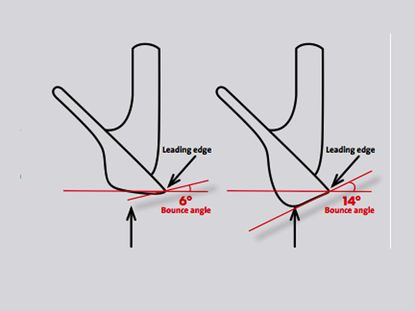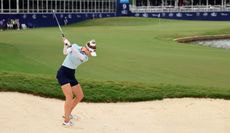Using the bounce video
Golf Monthly Top 25 coach Andrew Reynolds explains what the bounce angle of a club is, and how using the bounce can help your game.


Golf Monthly Top 25 coach Andrew Reynolds explains what the bounce angle of a club is, and how using the bounce can help your game.
Most club golfers are pretty clued up these days when it comes to the loft on their golf clubs, but bounce is perhaps less well understood, even though it’s equally as important.
All wedges, and indeed irons, have a leading edge, a sole and a trailing edge. The bounce in golf clubs was originally designed for sand irons.
When the trailing edge hit the ground, the club would bounce through and out of the sand, bringing the ball up and out with it, rather than the club simply burying itself in the sand via the leading edge, and the ball not going very far as a result.
Most wedges now have two numbers stamped on them: the loft – typically 46 to 60 degrees – and the bounce, which ranges from around six to 14 degrees, with most between eight and 12 degrees. Anything more than ten degrees is quite a lot, especially for pitching.
However, where you play your golf can have a big bearing on your ideal bounce. I play most of mine at Royal Cinque Ports, a links course in Kent, and both my 52 and 58-degree wedges have eight degrees of bounce, so I can get to the bottom of the ball on the tight links turf and make decent contact.
If you play at lusher parkland courses, you’ll need more bounce to stop the leading edge digging in too much.
Get the Golf Monthly Newsletter
Subscribe to the Golf Monthly newsletter to stay up to date with all the latest tour news, equipment news, reviews, head-to-heads and buyer’s guides from our team of experienced experts.
When it comes to bounce, it’s very much horses for courses... or clubs for courses. But you’ll encounter a variety of lies at any course, so you’ll have to play the percentages and think about what degree of bounce is going to be most useful to you.
Why is it so important?
In some ways, bounce is more important than loft – while you can always make a clean strike with the wrong loft, the wrong bounce for the shot in hand will severely limit your options, or make things physically impossible.
This wedge has 12 degrees of bounce – pretty high. You can see that I can’t get the leading edge under the bottom of the ball from a tight lie with a normal set-up.
To do so, I have to move the shaft in front of the club. I can then make decent contact, but because I’ve delofted the club, I’m now going to be driving the ball forwards more.
That’s fine in some situations, but if you’re facing a high lob off a tight lie over a bunker or up a bank, you’re in trouble.
People instinctively open the clubface to create more loft, but this increases the bounce further and makes things worse.
The result will be that you make contact a third of the way up the ball. If you encounter lots of tight lies where you play, low-bounce wedges are a good idea.
From the rough
If the ball’s sitting in a fluffy lie or off the ground a little, more bounce will help keep the club moving forwards through impact.
If you don’t have enough bounce here, the leading edge may dig in too much, leading to poor contact.
As a rule, the grassier the lie, the more bounce you need to play the shot effectively, allowing you to get to the bottom of the ball and float it up and away without snagging.
From the sand
Bounce comes into its own on greenside splash shots, where you have to get the ball up quickly. You want the club to enter the sand about two inches behind the ball.
If you do this with insufficient bounce, the club will simply dig into the sand, and you won’t have to move far for your next shot!
Setting up with the clubface open and the ball closer to your left heel, as you would typically do in a bunker, actually increases bounce angle further.
Once the club hits the sand, using the bounce will help keep the club moving forwards under the ball, bringing the ball out on a little bed of sand.

Tom Clarke joined Golf Monthly as a sub editor in 2009 being promoted to content editor in 2012 and then senior content editor in 2014, before becoming Sports Digital Editor for the Sport Vertical within Future in 2022. Tom currently looks after all the digital products that Golf Monthly produce including Strategy and Content Planning for the website and social media - Tom also assists the Cycling, Football, Rugby and Marine titles at Future. Tom plays off 16 and lists Augusta National (name drop), Old Head and Le Touessrok as the favourite courses he has played. Tom is an avid viewer of all golf content with a particularly in depth knowledge of the pro tour.
-
 'I Cannot Believe This Is Real' - Emotional So Yeon Ryu Reflects On Retirement After Chevron Championship Missed Cut
'I Cannot Believe This Is Real' - Emotional So Yeon Ryu Reflects On Retirement After Chevron Championship Missed CutThe two-time Major champion missed the cut at the Chevron Championship in what is her last tournament as a professional
By Ben Fleming Published
-
 The Chevron Championship Tee Times - Round Three
The Chevron Championship Tee Times - Round ThreeJin Hee Im and Atthaya Thitikul share the lead at eight-under-par, but World No.1, Nelly Korda, is only one shot back of the pair
By Matt Cradock Published